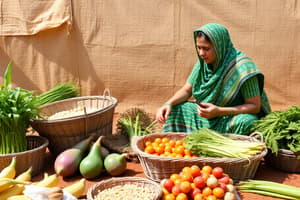Podcast
Questions and Answers
What is a major barrier to food acquisition according to the text?
What is a major barrier to food acquisition according to the text?
- Lack of government subsidies
- Crop failure
- Poverty (correct)
- High food prices
Which government program empowers rural women through self-help groups and entrepreneurship development?
Which government program empowers rural women through self-help groups and entrepreneurship development?
- National Rural Livelihood Mission (NRLM) (correct)
- Pradhan Mantri Awas Yojana (PMAY)
- Pradhan Mantri Kisan Samman Nidhi (PM-KISAN)
- Atmanirbhar Bharat Abhiyan
What does the National Food Security Act (NFSA) mainly provide subsidies for?
What does the National Food Security Act (NFSA) mainly provide subsidies for?
- Nutritious food
- Food grains (correct)
- Cash transfers
- Agricultural equipment
What is one of the key aims of the Pradhan Mantri Awas Yojana (PMAY)?
What is one of the key aims of the Pradhan Mantri Awas Yojana (PMAY)?
Why are agroecological practices and climate-resilient crops considered crucial for sustainable agricultural growth?
Why are agroecological practices and climate-resilient crops considered crucial for sustainable agricultural growth?
What is the primary mechanism for providing food grains at affordable prices to the poor in India?
What is the primary mechanism for providing food grains at affordable prices to the poor in India?
Which factor is closely tied to the prevalence of malnutrition among women in India?
Which factor is closely tied to the prevalence of malnutrition among women in India?
What percentage of Indian children under five years of age suffer from stunting?
What percentage of Indian children under five years of age suffer from stunting?
What has helped reduce fraud and improve transparency in the distribution of food grains through the PDS in India?
What has helped reduce fraud and improve transparency in the distribution of food grains through the PDS in India?
Which agricultural intervention could help alleviate food insecurity in India?
Which agricultural intervention could help alleviate food insecurity in India?
Flashcards are hidden until you start studying
Study Notes
Food Security in India: Challenges and Initiatives
Amidst a growing global population and the complex interplay of socio-economic factors, food security in India remains a multifaceted issue. To grasp the essence of this complex subject, let's delve into the subtopics of food distribution, malnutrition, agricultural productivity, poverty and food access, and government programs aimed at addressing this critical matter.
Food Distribution
With a diverse, yet-to-be-fully-realized agricultural landscape, India faces challenges in equitably distributing food resources to its citizens. The Public Distribution System (PDS) has been a primary mechanism for providing food grains at affordable prices to the poor, yet it has faced criticism for inefficiencies and leakages. The introduction of the Aadhaar-based biometric authentication for the PDS, known as Aadhaar-enabled Payment System (AEPS), has helped to reduce fraud and improve transparency.
Malnutrition
Despite India's agricultural strength, the nation's fight against malnutrition remains a daunting task. Approximately 34% of Indian children under five years of age suffer from stunting, and 19% are underweight. The prevalence of anemia among women of reproductive age is 53%, and 36% of women are underweight. This issue is closely tied to poverty and lack of access to nutritious, balanced diets, which underscores the need for targeted interventions and holistic approaches.
Agricultural Productivity
Agricultural productivity, characterized by high-yielding crops and efficient farming techniques, plays a pivotal role in ensuring food security. India's Green Revolution, launched in the 1960s, significantly increased food production, yet concerns about groundwater depletion and the need to diversify crop production persist. The promotion of agroecological practices and the adoption of climate-resilient crops are crucial for sustainable agricultural growth.
Poverty and Food Access
Food access is another critical aspect of food security. Poverty is a major barrier to food acquisition, while an estimated 18% of Indians still lack access to adequate food. The National Food Security Act (NFSA) provides subsidies for food grains, yet it does not address the issue of nutritional deficiency or the lack of access to nutritious food. The government's recent expansion of the NFSA to cover an additional 230 million people represents a significant step towards improving food access for India's economically disadvantaged.
Government Programs
The Indian government has implemented numerous programs aimed at improving food security. Among them, the Mahatma Gandhi National Rural Employment Guarantee Act (MGNREGA) provides employment opportunities in rural areas, thereby enabling villagers to have a steady income and access to food. The National Rural Livelihood Mission (NRLM) empowers rural women through self-help groups and entrepreneurship development.
The Pradhan Mantri Kisan Samman Nidhi (PM-KISAN) offers direct cash transfers to small and marginal farmers, while the Pradhan Mantri Awas Yojana (PMAY) provides housing to economically disadvantaged groups. The Atmanirbhar Bharat Abhiyan, launched in 2020, aims to promote self-reliance in various sectors, including agriculture.
While India has made significant progress in food security, the challenges it faces are complex and multifaceted. The combination of reducing malnutrition, improving agricultural productivity, and ensuring equitable food distribution through government programs represents a holistic approach to achieving food security for all Indians.
Studying That Suits You
Use AI to generate personalized quizzes and flashcards to suit your learning preferences.



